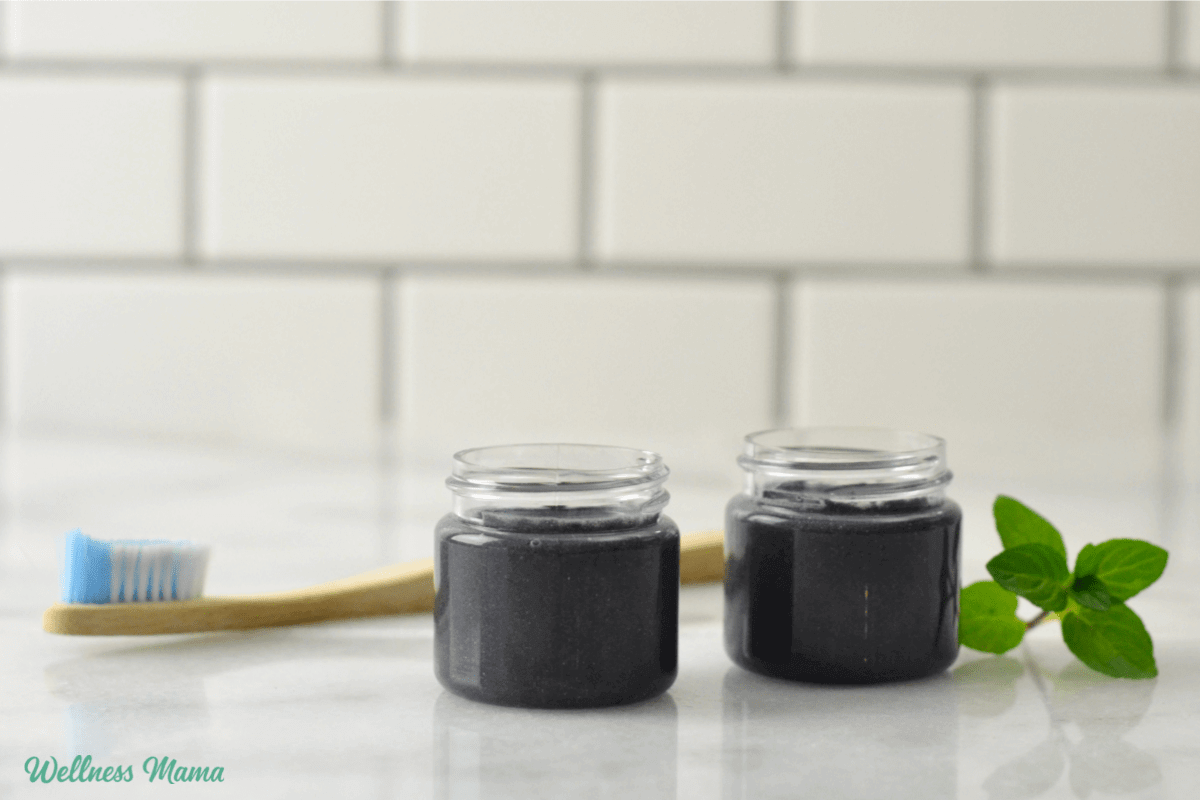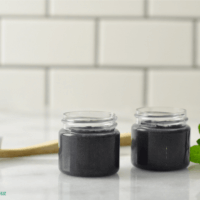We all want to know how to whiten teeth naturally, but getting it done is another matter. Harsh whitening strips and pastes are a no-go for me. This whitening toothpaste recipe with charcoal is an easy, gentler way to get a brighter smile.
Avoiding Harsh Teeth Whitening
Those slick ads with gorgeous smiles can be pretty tempting, but our family avoids artificial whitening. Chemical whiteners can cause sensitivity, gum irritation and burning, and permanent enamel damage. Scientists aren’t entirely sure how tooth bleaching even works or the full scope of its effects.
At-home whitening treatments use hydrogen peroxide to remove stains and discoloration. Research shows that may not be the best idea for dental health though. Several studies show hydrogen peroxide bleaching agents damage dentin, the tooth layer underneath the enamel. Weaker teeth mean a higher chance of tooth decay.
Just because something is approved by the American Dental Association (ADA) doesn’t mean it’s safe! Take fluoride for example.
A Natural Way to Whiten Teeth
I write a lot about oral health, and I’m fascinated with how it affects the whole body! I’ve spent years creating natural toothpaste and oral care. I wanted something safe enough for my kids to use and also not aggravate my health issues. Plus it had to help prevent bad breath and have whitening properties.
I’ve experimented with various natural teeth whiteners over the years (including turmeric). But I wanted to make a homemade toothpaste that had the same effect with less mess.
While you can buy many excellent natural toothpastes (one from yours truly!), I used this cost-effective DIY recipe for years. (Because, um, 6 kids!). It’s my favorite toothpaste recipe so far and the least expensive. It’s also the best whitening toothpaste I’ve used, especially when combined with oil-pulling.
Natural Oral Care Options
Some of my favorite healthy mouth recipes to date are:
- Homemade Remineralizing Toothpaste
- Remineralizing Tooth Powder Recipe
- Homemade Mouthwash
- Whitening Teeth With Charcoal
- Oil Pulling
My other toothpaste recipes get a lot of comments about substitutions, and if certain ingredients are necessary. Since the other recipes use coconut oil, some people complain the toothpaste is too hard to use when it’s cool.
This whitening toothpaste recipe is simpler and uses only the most beneficial ingredients. It’s the same consistency at any temperature, works well, and tastes great. Even my kids like the taste, and I don’t have to freak out if they swallow some.
How Does Natural Whitening Toothpaste Taste?
Natural toothpaste may not be as sweet as conventional, and it doesn’t have the foaming action. This recipe doesn’t have any baking soda in it, so it’s not salty like some natural options. I add a blend of essential oils to our toothpaste to customize the flavor. The essential oils also have antimicrobial properties that help with oral hygiene.
Essential Oils for Toothpaste
Not every essential oil is safe to put in your mouth, and some that are safe for adults aren’t safe for kids. We also have to consider how much of each oil we’re using. Irritating essential oils like cinnamon and peppermint essential oil should be used more sparingly than something like orange.
Essential oils are optional, but they really help improve the taste. Peppermint, cinnamon, and clove can be too harsh for young kids, but mine really love grapefruit or lemon!
Not only do they improve the flavor of the DIY toothpaste, but they have antimicrobial benefits for mouth health. Here are some safe essential oils choices for your whitening toothpaste.
- Peppermint
- Spearmint
- Orange
- Grapefruit
- Lemon
- Tangerine
- Bergamot
- Lime
- Myrrh
- Cinnamon (use sparingly)
- Clove (use sparingly)
- Tea tree (tastes best when combined with other essential oils)
A Weird Way to Whiten Teeth
I’ve found calcium and MCT oil do a good job of whitening on their own, but there’s a way to boost the whitening power. Activated charcoal (AC) is one of my favorite ways to whiten teeth. I was pretty skeptical at first, but it’s really grown on me. AC is good at removing surface stains on tooth enamel from foods like coffee and tea.
From the research I’ve done, I’ve found AC is safe to use with fillings and veneers and won’t leach minerals from teeth. Charcoal improves mouth pH and makes it more alkaline to help prevent cavities and gingivitis. That’s why it’s one of the main ingredients in my Wellnesse Charcoal Toothpaste.
If you have any concerns about using your own toothpaste with your dental work though, check with your dentist first!
Benefits and Cautions of Xylitol
If I add something sweet to our meals I go for natural options like honey, maple syrup, or coconut sugar. Sweeteners like xylitol aren’t something you’re going to see in my recipes. So why use it in toothpaste?
There’s some evidence that xylitol benefits oral health. Specifically, it helps reduce plaque and cavities while it kills bacteria. Big caution here though… xylitol even in small amounts can be deadly to dogs. So don’t keep your toothpaste where Fido can eat it!
The xylitol I use is a little coarse so I ran it through the blender first. You could also use a coffee grinder. The second time I made the toothpaste, I just put all of the ingredients in the blender and it came out all creamy.
The blender was tough to clean after my experiment, but a quick wipe with the paper towel helped. Once I got the residue, out I washed my blender as usual.
MCT Oil for Teeth
Medium-chain triglyceride or MCT oil is my secret ingredient in this recipe. It’s derived from coconut or palm oil but stays liquid at different temperatures so it’s easier to work with. Fractionated coconut oil is similar to MCT oil, but it’s usually for skincare only and isn’t safe to eat.
It can get confusing because sometimes manufacturers use terms like liquid coconut oil or fractionated MCT oil. Bottom line, we’re using liquid coconut oil that’s high in MCTs and food grade.
Homemade Whitening Toothpaste
Equipment
- Coffee grinder (optional)
- Blender (optional)
Materials
- ¼ cup calcium carbonate powder
- 3 TBSP xylitol powder
- ¼ cup MCT oil
- 2 tsp activated charcoal powder
- 20-30 drops essential oils (see options above)
Instructions
- Make sure the xylitol is finely ground and not coarse. Grind it in the blender or coffee grinder if necessary.
- Mix all the ingredients by hand in a small bowl or with a blender until incorporated.
- Store in a glass jar or squeeze tube and brush as usual.
Notes
- For easy blender clean-up, add a few drops of soap to the blender and then fill one-third full with warm water. Put the lid on tightly and blend on high. Dump out the suds and rinse well.
- Storage and Shelf Life: Keep away from very warm areas and don’t allow water to get in the toothpaste jar. For longer shelf life use a clean popsicle stick or other utensil instead of dipping the toothbrush directly into the jar.
How to Store Natural Whitening Toothpaste
When I make toothpaste, each person in our family gets their own jar. This helps prevent bacteria from being swapped back and forth and everyone gets their favorite flavor. We just dip our toothbrushes in the jar but a popsicle stick is another option. A clean popsicle stick can help prevent microbes from growing in the toothpaste. If you’re using essential oils these also have some preservative properties.
Like most of my toothpaste recipes, I like making this in small batches because the shelf life isn’t as long as store-bought. If your family is a lot smaller than mine you could also cut the recipe in half. Be sure to pitch your whitening toothpaste if you notice any off-smell or color.
The shelf life depends on several factors but mine typically lasts for several weeks at least. If you’re not down with the jar, then a squeeze tube like this one is another option.
Have you ever tried natural teeth whitening before? What’s worked for you? Leave a comment and let us know!



Leave a Reply